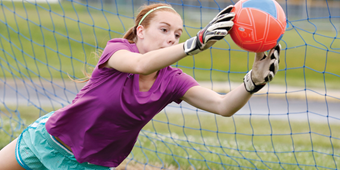Are These Fitness Trends Fit for You?

Find Your Perfect Match
Answer a few questions and we'll provide you with a list of primary care providers that best fit your needs.
Keeping up with physical fitness trends and deciding which are the best fit for you can be a workout in itself.
Your goal is finding physical fitness activities — whether they’re trending or not — that are most likely to propel you toward the weekly physical activity target recommended by the Department of Health and Human Services. That is, at least 150 minutes of moderate-intensity aerobic physical activity and two days of muscle-strengthening exercise.
“The key is finding a fitness routine that you can stick with so you’ll achieve the health and wellness benefits of exercise for the long term,” says Premier Health Athletic Trainer Joel Russo. “For your best chance of success, choose activities that fit your budget, your lifestyle, your current health status and your personal preferences. For instance, are you an outdoor person or an indoor person? Keep in mind that fitness is a life-long commitment, not a quick fix.”
And if you haven’t been physically active lately, or you’re being treated for a chronic health condition, Russo recommends talking with your doctor for her suggestions or thoughts on current fitness trends you’ve heard or read about.
 Sizing Up Fitness Trends
Sizing Up Fitness Trends
Here’s a rundown of current fitness trends. The first three made the top of the list in a survey of thousands of fitness professionals published in the American College of Sports Medicine’s Health & Fitness Journal.
Wearable technology. Unlike the others that follow, this is not a fitness regimen. Rather, these are devices that help you track your physical fitness efforts. They include smart watches, fitness trackers, heart rate monitors and GPS devices. They provide a degree of motivation, for instance, if you get satisfaction from watching your daily step count approach your goal — say, 10,000 steps. But you can meet your fitness goals without devices like these. And they’re no guarantee you’ll get off the couch.
Body weight exercises. Body weight exercises such as push-ups, planks, pull-ups or calf-raises, to name a few, have been around a long time. But they’re regaining popularity as a no-cost, no-tech fitness solution that puts your body weight to work for you, whether you want to shed some pounds or keep your body strong and toned. You can do them anywhere — at home, in a park, or a class or gym, if you prefer. Body weight exercises can be used to tone all your muscles, not just one muscle group.
High-intensity interval training (HIIT). Popular among busy people, HIIT sessions can be done in 30 minutes or less. They involve short bursts of high-intensity exercise followed by a short period of rest or recovery. HIIT brings results, burning calories and fat, even hours after a workout. HIIT requires minimal equipment and can be done at home, at the gym or in a park. The downside: The quick movements of HIIT can raise your risk of injury and muscle strain. It may not be a good choice if you’ve been inactive. However, HIIT can be modified to help you build intensity over time.
Cross Fit. Another high-intensity workout, Cross Fit combines weight lifting, gymnastic exercises and boot camp-style exercises. The workouts are usually done in a team environment and vary day to day to prevent boredom and promote motivation. Cross Fit is most appropriate for those experienced in athletics and intense training. For others, Cross Fit can be hazardous. Certain Cross Fit exercises, such as box jumps, put a lot of stress on joints. So they can be harmful for overweight exercisers. Cross Fit typically involves a monthly gym membership fee that includes a certified trainer who also offers nutrition guidance.
The key is finding a fitness routine that you can stick with so you’ll achieve the health and wellness benefits of exercise for the long term.
Online programs. While they offer convenience 24/7, online fitness programs don’t come with the motivation and accountability you get from an instructor and classmates at a fitness center. And there’s no instructor to correct your form and save you from possible injury. However, a vast array of online exercise programs are only a click or two away, in the comfort and privacy of your own home. Plus, most are free or less expensive than gym programs. Narrowing down online programs that are a good fit for you, and of good quality, can be a challenge.
Barre fitness. Based on classic ballet positions that focus on the core and lower body, barre fitness improves flexibility, balance and stability. Through small, repetitive, isolated movements, barre develops long, lean, strong muscles. Barre appeals to people who took dance classes as children or enjoy dancing. These classes, however, do not include aerobic exercise, so may have limited effectiveness for weight loss.
Yoga. Yoga continues to be a popular fitness alternative that addresses physical and mental health. It reduces stress, anxiety and chronic disease risk factors such as high blood pressure. At the same time, yoga improves balance, flexibility and strength. Yoga comes in a variety of styles. Most forms typically do not burn enough calories for weight loss. Beginners are often advised to avoid extreme positions such as headstands, as they can result in injury. If you practice hot yoga, which is conducted in a heated room, drink plenty of water. This form can be harmful to pregnant women and people with high blood pressure.
Find Your Perfect Match
Answer a few questions and we'll provide you with a list of primary care providers that best fit your needs.
Source: American College of Sports Medicine; Healthline; Joel Russo, AT, CSCS, Premier Health Sports Medicine





